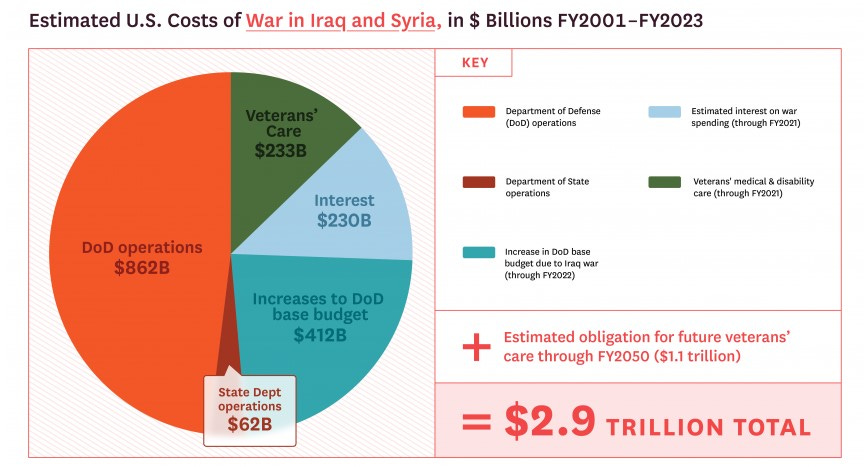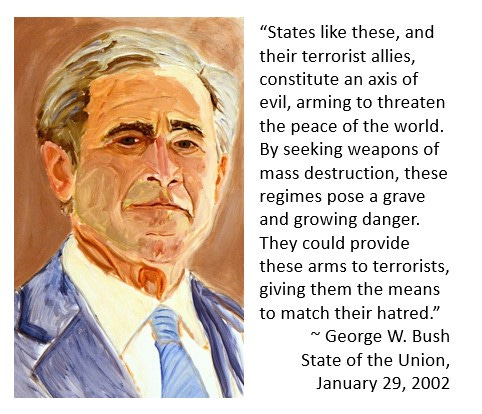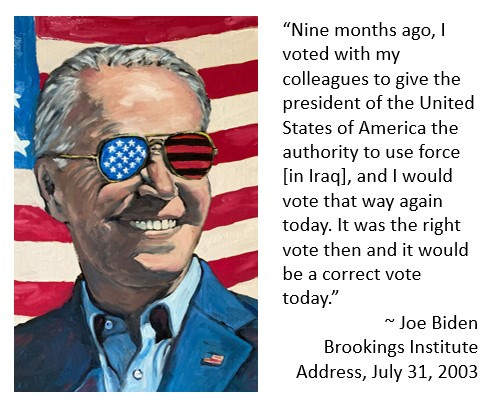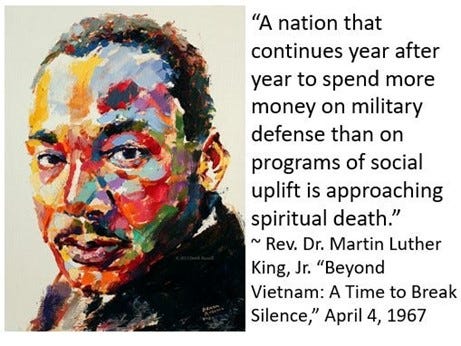Invading Iraq: A Bipartisan Tragedy
Part I of a series exploring the Iraq War, 20 years following the invasion
On March 20, 2003, hours before daybreak, President and Commander in Chief George W. Bush launched a massive aerial assault on Iraq’s capital city, Baghdad. The Bush administration’s military aim was to “decapitate” Iraq’s leadership. The “shock and awe” bombardment came to a grim and cacophonous crescendo on March 21. An IT News reporter in Iraq described it this way:
“Last night a square mile in central Baghdad seemed like hell on earth. An inferno…. This isn't just an attack on bricks and mortar. It is an assault on human senses.”
The U.S. and its coalition forces, including the United Kingdom, Australia and Poland, captured Iraq’s capital in less than a month. On May 1, 2003, President Bush stood in front of a “Mission Accomplished” banner and proclaimed an end to “major combat operations.”

The Bush administration insisted that Iraq had Weapons of Mass Destruction (WMD), and that a preemptive invasion was necessary to prevent Saddam Hussein from using the weapons to hurt the U.S. and its allies. Given the deference so many journalists and ordinary citizens had for government officials concerning WMD, it is important to document some of the numerous instances in which the Bush administration made their case for war with shamelessly exaggerated confidence.
On January 29, 2002, just four months after the September 11th attacks, President Bush delivered a State of the Union Address in which he first warned the nation of a menacing “axis of evil” that included Iraq, Iran, and North Korea. A traumatized, fearful nation listened as President Bush stated, “By seeking weapons of mass destruction, these regimes pose a grave and growing danger. They could provide these arms to terrorists, giving them the means to match their hatred.” Bush explained that Iraq was hostile to the U.S., supported terrorism, and continued plotting to “develop anthrax, and nerve gas, and nuclear weapons….”
The Bush administration continuously stoked the fire of fear in the public. In August 2002, Vice President Dick Cheney said, “there is no doubt that Saddam Hussein now has weapons of mass destruction. There is no doubt he is amassing them to use against our friends, against our allies, and against us.” One month later, National Security Adviser Condoleezza Rice ratcheted up the rhetoric with allusions to atomic war. In a CNN interview with Wolf Blitzer she said, “The problem here is that there will always be some uncertainty about how quickly he [Saddam Hussein] can acquire nuclear weapons. But we don’t want the smoking gun to be a mushroom cloud.” Defense Secretary Donald Rumsfeld went so far as to tell the Senate Armed Services Committee, on September 19, 2002, that “no terrorist state poses a greater or more immediate threat to the security of our people than the regime of Saddam Hussein and Iraq.”
The drumbeat for war continued in the new year. During a February 5, 2003, U.N. Security Council presentation, Secretary of State Colin Powell stated, “the facts and Iraq's behavior show that Saddam Hussein and his regime are concealing their efforts to produce more weapons of mass destruction.” Six days later, then FBI Director, Robert Mueller, told Congress that “Iraq's WMD program poses a clear threat to our national security, a threat that will certainly increase in the event of future military action against Iraq.” Weeks into the war, on April 10, 2003, the White House press secretary, Ari Fleischer, said the Bush administration had “high confidence” WMDs would be found. He also affirmed that WMD “is what this war was about and is about.”
Biden’s Case for the Iraq War
For good reason, the Iraq War is often placed at the feet of former president George Bush and the Republican elected officials who supported the effort. But inadequate attention is given to the leading role then-senator and now president, Joe Biden, played in paving the way for the Bush administration’s march to war.
Bidden used his position as chair of the Senate Foreign Relations Committee to insist Iraq had WMD. Biden held a hearing on Iraq between July 31 and August 1, 2002 but excluded the lead U.N. weapons inspector in Iraq from 1991 and 1998, Scott Ritter. Ritter warned that the hearings would be little more than a parade of rationalizations for war unless the committee asked serious questions about WMD claims and demanded evidence over speculation. But Biden’s opening statement made it clear that he had taken for granted precisely what was in question.
“These weapons must be dislodged from Saddam Hussein, or Saddam Hussein must be dislodged from power. President Bush has stated his determination to remove Saddam from power, a view many in Congress share.”
Despite gesturing toward investigating the facts, Biden’s mind had been made up for years. During a 1998 senate foreign relations hearing Biden mocked Ritter’s requests for greater international assistance to allow inspectors to complete their job in Iraq. Biden stated,
“…as long as Saddam is at the helm, there is no reasonable prospect you or any other inspector is ever going to be able to guarantee that we have rooted out, root and branch, the entirety of Saddam’s program relative to weapons of mass destruction.”
Not only had Biden concluded that Iraq had WMD, he had also concluded that the United States ought to invade Iraq to remove Hussein from power. In the same 1998 hearing, Biden insisted,
“the only way we’re going to get rid of Saddam Hussein is we’re going to end up having to start it alone…and it’s going to require guys like you in uniform to be back on foot in the desert taking this son of a—taking Saddam down.”
During a classified hearing, on September 24, 2002, Biden asked then CIA director, George Tenet, what hard evidence U.S. intelligence had collected to prove Iraq had WMD. Tenet gave a two word reply, “None, Senator.” But Biden was not dissuaded.
We would do well to recall that leading members of the Democratic Party joined with Republicans to give the Bush administration the legal authority to use military force in Iraq. On October 11, 2002, 48 Republicans voted for the unambiguously named resolution, “Authorization for Use of Military Force Against Iraq Resolution of 2002” (AUMF). They were joined by 28 Senate Democrats including Joe Biden, Hillary Clinton, Dianne Feinstein, John Kerry, and Chuck Schumer. Biden later co-sponsored the resolution commending Bush’s invasion, putting an exclamation mark on his support for the invasion.
A Hawk Becomes a Dove: How Biden Misrepresented his Iraq Position
During the 2020 presidential campaign, Joe Biden erroneously stated that he did not support the invasion of Iraq. He went so far as to claim that his support for the war authorization was intended to facilitate weapons inspection and that he did not believe Saddam Hussein had WMD.
"I didn't believe he had those nuclear weapons. I didn't believe he had weapons of mass destruction. What happened was we went in, determined that they hyped what in fact was occurring, there was no concrete proof of what he was doing and they still went to war."
Biden also falsely stated that he opposed the war from its start. During a July 2019 debate, he said: “From the moment ‘shock and awe’ started, from that moment, I was opposed to the effort, and I was outspoken as much as anyone at all in the Congress and the administration.”
Four months into the war, on July 31, 2003, Biden touted bipartisan support for the Iraq War and what he called “enlightened nationalism” before an audience at the Brookings Institution. Biden insisted that authorizing President Bush to use force was the right decision.
“Nine months ago, I voted with my colleagues to give the president of the United States of America the authority to use force, and I would vote that way again today. It was the right vote then and it would be a correct vote today.”
In 2014, the Obama administration relied upon the 2002 AUMF for authorization to conduct airstrikes in Syria against members of the Islamic State of Iraq and Syria (ISIS), a group that emerged and flourished in the wake of the Iraq War. The war authorization of use of force was not officially repealed by the Senate until March 29, 2023.
Costly Consequences of War
Iraq did not possess WMD. In October 2004, post invasion inspectors tasked with locating weapons determined Iraq ceased production of such weapons in 1991. In other words, Iraq had given up their weapons of mass destruction 12 years before the U.S. invaded Iraq, ostensibly to eliminate such a program. The Bush administration and leading political figures of both parties including senators Joe Biden and Mitch McConnell were wrong.

In a 2006 press briefing, President Bush explicitly stated Iraq had “nothing” to do with the September 11, 2001 attack and did not possess WMD. In Decision Points (2010), President Bush wrote that he was “shocked and angry” that the weapons were not found. “I had a sickening feeling every time I thought about it. I still do.” Indeed, Bush, Biden, and the many who endorsed the Iraq War have much to feel sickened about.
U.S. leaders’ decision to invade Iraq caused the deaths of more than 4,400 U.S. soldiers. Another 32,000 U.S. soldiers were physically wounded. This is to say nothing of a nearly incalculable psychological toll war takes on participants. One indication of the psychological violence of war is the fact U.S. soldiers take their life at a higher rate than do those like them outside of the military. More than 30,000 U.S. service members and veterans who served since September 11 have taken their lives, a figure four times that of the battlefield deaths across all U.S. military conflicts since 2001.
The liberality with which money is freely spent on the military renders absurd claims that the U.S. lacks resources to ensure their citizens possess security of housing and health.
The people allotted the greatest share of suffering, trauma, death, and destruction were the people given no say in launching the war: the Iraqi people. Between March 20, 2003 and the end of 2011 a total of 280,000 Iraqi civilians died from causes directly tied to the war. For perspective, this is a figure nearly 17 times greater than the population of the small city I live in. The civilian Iraqi death toll is greater than the population of one the fastest growing states in Florida, Port St Lucie, which has just over 217,000 residents. Against Bush administration insistence that the Iraq War was a war for “freedom,” we cannot look away from the gruesome fact that the decision to invade Iraq directly contributed to the deaths of more than a quarter-of-a-million innocent people. The actual civilian death toll is much larger when factoring deaths indirectly resulting from the war. As the Cost of War Project explains, “Several times as many Iraqi civilians may have died…due to damage to the systems that provide food, health care and clean drinking water, and as a result, illness, infectious diseases, and malnutrition that could otherwise have been avoided or treated.”

The bipartisan misadventure in the Middle East has and continues to come at a high economic price as well. According to a March 2023 report by Brown University’s “Cost of War Project,” taxpayers are expected to have spent $2.9 trillion by 2050 for military efforts in Iraq and Syria.

Though little discussed or scrutinized in public discourse, the U.S. operates a military base in opposition-held Syria, a nation the U.S. has not declared war against and has not received permission to operate within. The fact of this military presence was brought to public view in March 2023 when media outlets reported that a drone strike killed a contractor and injured four American soldiers in Syria. The Biden administration retaliated with airstrikes on Iranian forces operating inside Syria. Previously, president Donald Trump ordered airstrikes against Syria in April 2017 and again in 2018. Meanwhile more than 2,500 U.S. troops continue to operate in bases throughout Iraq.
The economic costs of the Iraq War are particularly noteworthy given the frequent claims of U.S. political leaders that the government does not have the economic resources to fund social programs to enhance and save the lives of its citizens. Most recently, many Republicans have called for cuts or significant changes to social security and Medicare. Meanwhile the Biden administration quietly decided not to renew the public health emergency declaration issued in March 2020 for the coronavirus pandemic. According to the U.S. Department of Health and Human Services, the predicted consequences from the sunsetting of the declaration is that as many as 8.2 million individuals will lose Medicaid eligibility and another 6.8 million will lose Medicaid coverage “despite still being eligible” due to administrative factors.
The liberality with which money is freely spent on the military renders absurd claims the U.S. lacks resources to ensure their citizens possess security of housing and health. Our leaders have decided to spare no expense on military endeavors—”spreading freedom and democracy,” we are told. Money is no object. The purse strings are closed, however, at the mention of student debt forgiveness, help with out-of-control housing costs, and addressing thousands of deaths that occur each year due to inadequate healthcare.
Perhaps we can do no better than to once again remind ourselves of Rev. Dr. Martin Luther King’s insistence that the economic prioritization of warfare portended spiritual catastrophe. In his controversial and widely condemned speech, “Beyond Vietnam: A Time To Break Silence,” delivered April 4, 1967, exactly one year before his assassination, King said,
“A nation that continues year after year to spend more money military defense than on programs of social uplift is approaching spiritual death.”
Twenty years after the Iraq War, trillions of dollars have been spent, tens of thousands have died, many more have been injured, and the Middle East is widely recognized as less stable. Those most responsible for these devastating effects have forgone accountability. Leading members of the Senate on both sides of the aisle who voted for the war continue to hold outsized sway in their party. At least one was politically promoted—to the office of the presidency, of all positions. And the man at the helm of the invasion has enjoyed a rehabilitation of image that includes celebrity friendship and exhibits of his paintings—paintings of wounded U.S. veterans, no less.
What exactly have we learned since 2003?
If you enjoyed this post please share it with others and like it by clicking the heart icon. Be sure to subscribe if you haven’t already.
Invite Dr. Nall to Speak
Dr. Nall delivers energetic live presentations and engaging workshops on the subjects featured in Humanities in Revolt. Those interested in booking a workshop or talk can get in touch through Facebook or by leaving a comment.








I appreciate the overview of how completely people in charge have failed those they represent. The ones you highlighted are just a few of the failures. It’s far from a US only problem.
Canadian politicians are rolling back many of the assistance programs that helped many financially deprived people during the pandemic. It’s been a slow roll back in some ways. In March 2020, Prime Minister Trudeau declared that no Canadian can live on less than $2,000 a month. But most people on welfare in Canada receive $700 a month from the government. The financial assistance programs that the government provided during CoVid have disappeared but the problem of poverty continues.